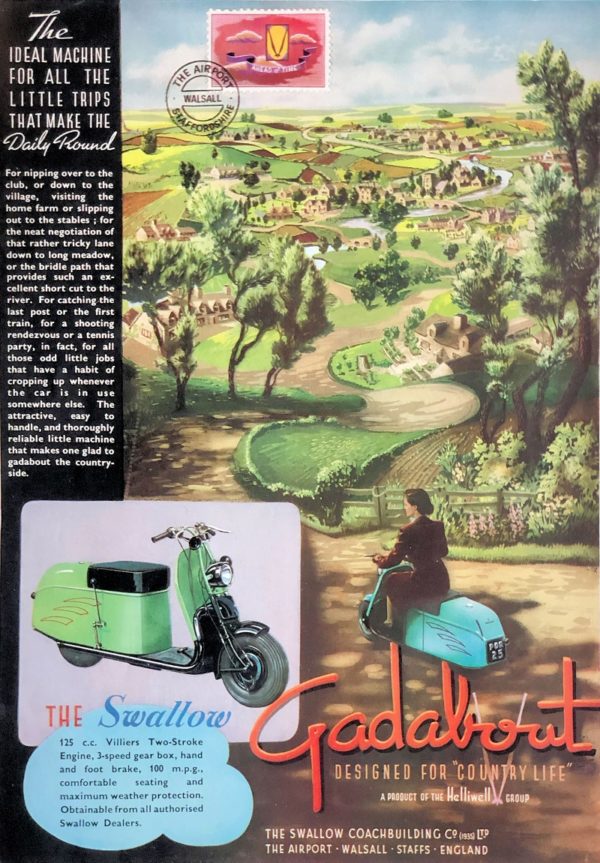
This 1948 advertisement may be colourful and confident – but the scooter it promotes was only produced from November 1946 to September 1951, by the Swallow Coachbuilding Company (1935) Ltd of Walsall in Staffordshire.
In December 1945 SS Cars Limited of Jaguar fame sold the name and goodwill of their sidecar business to the Helliwell Group, an aircraft servicing and repair firm. Eric Sanders, the managing director of Helliwell, got together with Frank Rainbow, a talented aero engineer and industrial designer. They had both seen the effectiveness of light scooters such as the Welbike during the war and thought that Swallow could make and successfully sell a similar machine.
Frank Rainbow’s brief was to produce a machine, powered by a Villiers engine, that could be built with a minimum of tooling and equipment. The strong ladder chassis was made in Wales by Tube Investments, who produced the Swallow sidecar chassis. The prototype and the first series machines used an “air dam” under the steel floor to duct air to the Villiers 9D 122cc engine. The bodywork was all steel, and access to the tank, tap and tools were under the seat. The Gadabout was announced to the motor cycle press and featured in “The Motor Cycle” on November 28th 1946, promoted as the “British Two-wheeler for Mr & Mrs Everyman”. It had early success as a lightweight runabout and was bought by public bodies that included the Staffordshire Constabulary. A problem arose with overheating in slow traffic, and Frank Rainbow designed a modified version with fan cooling. Altogether, some 2000 of this initial model were sold.
In 1949 the company launched the Mark II, with front suspension by rubber in torsion, a foot-change Villiers 10D engine and, naturally, the improvement of fan-cooling. Both the Mark I and Mark II could be bought with a Swallow box sidecar – turning them into the Gadabout Commercial. Some of these were fitted with the larger Villiers 6E 197cc engine, to become the Gadabout Commercial Major Mark III.
Our Snapshot shows an advertisement placed in Country Life in 1948 – which explains the very specific nature of the text, designed to appeal to the well-heeled ‘County’ set. It mentions “The little trips that make the Daily Round”, but these are far from the ordinary: “visiting the home farm”, “slipping out to the stables” or “for a shooting rendezvous or a tennis party”. A far cry from “Mr & Mrs Everyman.”
Although the Gadabout died in September 1951, Eric Sanders did commission Frank Rainbow to design a successor – the Joyrider. It was an elegant lightweight scooter, full of innovative ideas, powered by a Villiers 1F engine. The prototype survives, but sadly the project went no further. The name of Swallow continued for a short while; Frank Rainbow went on to design the excellent but short-lived Swallow Doretti sports car, launched in 1954 and made until 1955.
Picture courtesy of the Richard Roberts Archive







Leave a Comment